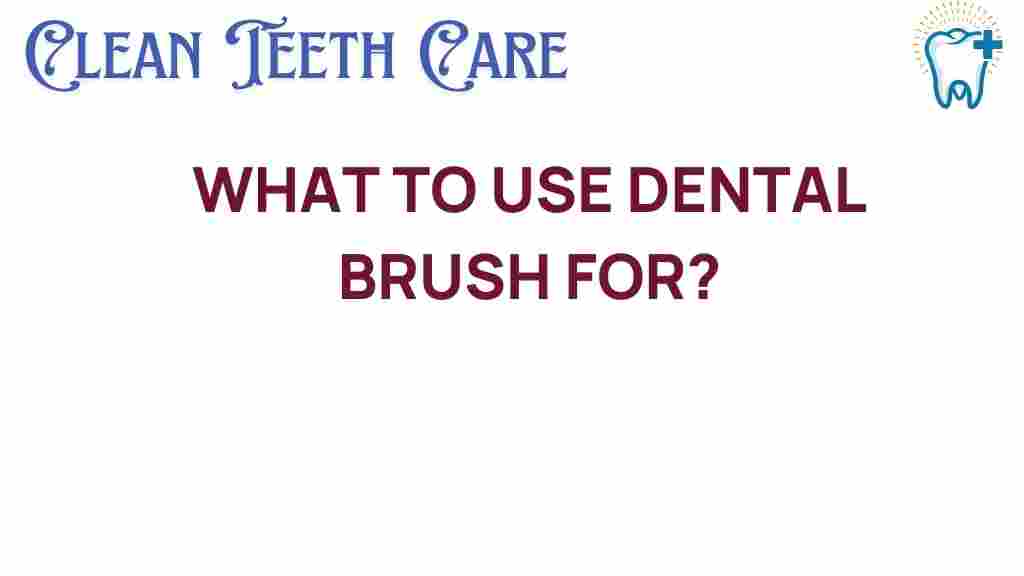Unveiling the Secrets: What You Can Really Use a Dental Brush For
When it comes to oral hygiene, the importance of a dental brush cannot be overstated. This simple yet powerful tool is fundamental in maintaining dental care, preventing plaque buildup, and ensuring overall gum health. In this article, we will explore the various uses of a dental brush, effective brushing techniques, and additional tips for enhancing your oral hygiene routine. By the end, you’ll uncover the secrets of maximizing your dental brush’s effectiveness for a healthier smile.
The Role of a Dental Brush in Oral Hygiene
A dental brush is primarily designed for cleaning your teeth, but its uses extend far beyond that. Here are some key benefits of using a dental brush:
- Plaque Removal: Regular brushing helps remove plaque, a sticky film of bacteria that forms on your teeth and can lead to cavities and gum disease.
- Gum Health: Proper brushing technique supports gum health by preventing gingivitis and periodontal disease.
- Tongue Cleaning: Some dental brushes come with a built-in tongue cleaner or can be used to brush the tongue, helping eliminate bad breath.
- Preventive Care: Consistent use of a dental brush is a key aspect of preventive care, reducing the likelihood of dental issues later on.
Choosing the Right Dental Brush
Selecting the right dental brush is crucial for effective cleaning. Here are some factors to consider:
- Bristle Type: Soft bristles are generally recommended for most individuals, as they are gentle on gums and enamel.
- Size and Shape: Choose a brush that comfortably fits your mouth and can reach all areas, including hard-to-reach spots.
- Manual vs. Electric: Both types can be effective, but electric brushes often provide more consistent pressure and may be easier for some to use.
Effective Brushing Techniques
To get the most out of your dental brush, it’s essential to employ effective brushing techniques:
- Angle: Hold your brush at a 45-degree angle to your gums to effectively remove plaque.
- Short Strokes: Use gentle, short strokes rather than aggressive scrubbing to protect your gums.
- Brush All Surfaces: Ensure you brush the outer, inner, and chewing surfaces of each tooth.
- Duration: Brush for at least two minutes, spending equal time on each quadrant of your mouth.
Step-by-Step Process for Brushing Your Teeth
Here’s a simple step-by-step guide for using your dental brush effectively:
- Prepare Your Brush: Wet the bristles and apply a pea-sized amount of fluoride toothpaste.
- Start with the Outer Surfaces: Begin by brushing the outer surfaces of your teeth, using gentle strokes.
- Brush Inner Surfaces: Repeat the process on the inner surfaces of your teeth, tilting the brush vertically to reach the back teeth.
- Chewing Surfaces: Brush the chewing surfaces with a back-and-forth motion.
- Tongue Cleaning: Don’t forget to clean your tongue to eliminate bacteria and freshen your breath.
- Rinse: Rinse your mouth thoroughly to remove any toothpaste and debris.
Additional Dental Tools for Comprehensive Care
While a dental brush is a crucial component of dental care, incorporating additional dental tools can enhance your oral hygiene routine:
- Dental Floss: Flossing daily can help remove plaque and food particles from between your teeth where your brush can’t reach.
- Interdental Brushes: These small brushes can clean between teeth and are especially useful for individuals with braces or wider gaps.
- Water Flossers: These devices use a stream of pulsating water to remove plaque and debris between teeth and along the gum line.
- Antiseptic Mouthwash: Rinsing with mouthwash can help reduce bacteria and freshen breath.
Troubleshooting Common Brushing Issues
Even with the best intentions, some common issues can arise during brushing:
- Sensitive Gums: If you experience sensitivity, consider using a soft-bristled brush and a toothpaste designed for sensitive teeth.
- Gum Recession: Avoid aggressive brushing, as it can contribute to gum recession. Focus on gentle techniques.
- Plaque Buildup: If you notice persistent plaque, consult your dentist for professional cleaning and advice on improving your brushing technique.
The Importance of Routine Dental Checkups
In addition to using a dental brush and other oral hygiene tools, regular dental checkups are vital for maintaining gum health and overall dental care. Your dentist can provide:
- Professional Cleanings: Removal of tartar buildup that brushing alone cannot eliminate.
- Cavity Detection: Early identification of dental issues before they become serious problems.
- Personalized Advice: Tailored recommendations based on your individual oral health needs.
For more detailed information on dental care practices, you can visit this resource.
Conclusion
Understanding the multifaceted uses of a dental brush is essential for effective oral hygiene and dental care. By mastering proper brushing techniques, incorporating additional dental tools, and maintaining a routine of preventive care, you can significantly enhance your oral health. Remember, a bright smile starts with a well-used dental brush, so make it a cornerstone of your daily routine. For more insights on maintaining your dental health, check out this guide that offers additional tips and resources.
This article is in the category Hygiene and created by CleanTeethCare Team
